
You find KNode in the K Menu under the entry Internet. The menu entry KNode launches the program.
 | If the entry for KNode can not be found or if KNode should not appear on the desktop after clicking on the menu entry, read Questions and Answers |
The main window of KNode should now be displayed on your desktop as shown. On first start, the settings dialog will be invoked.
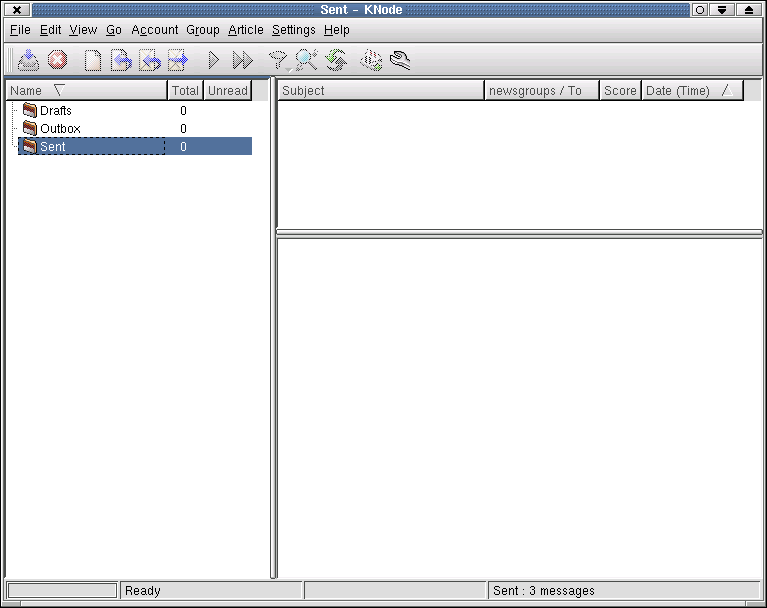
KNode after first start
The windows shows the menu bar, the toolbar below and the status pane at the buttom. The area between the toolbar and the status pane is occupied by a three-part windows.
On the left there is a folder view.It currently contains only three entries.
| Outbox |
| Drafts |
| Sent |
When KNode is completely and correctly configured, the news servers and the subscribed news groups will appear there.
In the upper-right section, is the article view. It is currently empty and does not show any articles. Directly below the article view, the article window is located. There appears the body of the currently selected article. These windows are also blank at the moment, as there are no articles, of course. You should not be confused because before reading and publishing news, some things have to be configured first. This will be covered by the following section.
We are now beginning the setting up of KNode. Most settings are not important for daily use, but you should know what settings are possible and what they are for. Some may miss a "Quickstart" chapter but those who prefer a quick start will just glance over the manual anyway. For others, especially those who have not any or much experience with a news reader, this chapter offers the chance to fully perform the configuration, although some things may become clear only later on.
Via Settings->Preferences you will enter the preferences dialog of KNode. The figure shows the dialog.
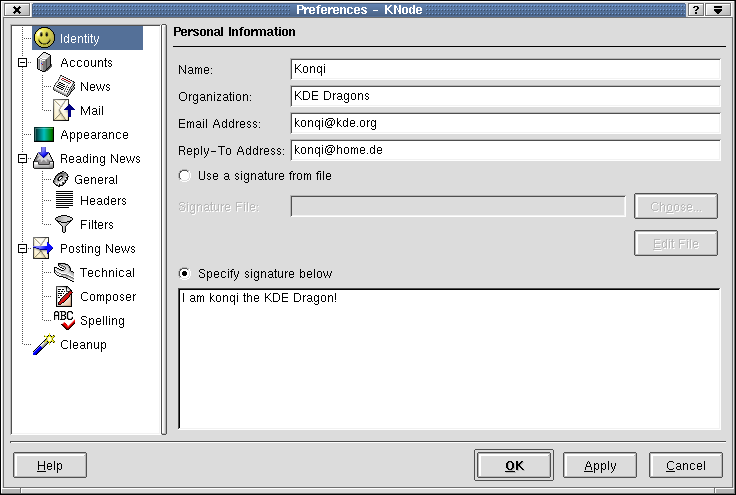
Entering the personal information
The dialog is divided into two parts: On the left, there is a treeview, in which the top entry Identity is already highlighted. On the right, you see the corresponding input dialog. These settings relate to your identity with which you navigate through the newsgroups.
 | If you have already configured your personal settings in the Control Center before the first start of KNode, they will be adopted. |
In the field Name you enter your name, e.g. Joe Miller or Mary Gordon. This name will later appear in the newsgroups as sender and can be seen by anyone.
Filling out the field Name is mandatory.
 | In most newsgroups, it is considered polite and appropriate to appear with one's real name. Other newsgroups are less strict about this. But there are also cases when one would not want to appear with one's real name, e.g. in newsgroups where one would like to (and can) talk about very personal matters without being exposed. These groups mostly do tell you in their Charter that the anonymity of their members is explicitly approved. |
 | For those special cases, KNode offers settings that can be adjusted to each newsgroup individually. Further information can be found under Group local Identities. |
The email adress you enter here will be used as sender in news articles, i.e. as actual address of the author, in conjunction with the real name (set in the field Name).
The field Email shows up when someone wants to reply to you by e-mail. The e-mail will be sent to the address entered here. Many newsreaders display the sender address together with the name in the Header of the article.
Filling out the field Emailis mandatory.
 | Note that the e-mail address will only be used for replies to you if the field Reply-to Address is not filled out. In this case, the field Email will be ignored for replies and the address given under Reply-to Address will be used. |
Reply-to Address offers you the possibility to enter a different address than your sender e-mail address. If someone replies to you by e-mail, this address will be displayed as target address in the reply. An example for using Reply-to Address would be that you write the article at the office during the day but want to receive the answer in your home inbox, because your boss co-reads your mail.
Only enter an e-mail address in that field if it actually differs from the field Email.
 | Some news readers deliberately set this to an invalid e-mail address in order to prevent spam mails from being received. What could happen though is that a reader sends an e-mail to this invalid address which you will therefore never receive. |
The input field Organization is optional and does not have to be filled out. You can enter e.g. the name of your company or your university institute, if you use KNode there. If you leave this field blank, it will often be filled out later by your Internet provider.
If this option is selected, the file specified under Signature File will be used as Signature.
The field Signature File determines the file, the content of which is appended to each of your articles. The field is only enabled if the option Use a signature from file is selected.
The signature file is a simple text file, which should not contain more than four lines. It can e.g. contain a reference to your homepage with the corresponding link, your postal address with your telephone number (which would then be of course visible to the whole world with every article) or just a cool quote. The signature is your brand, so to speak, which will mark all your articles. Therefore your signature should be designed sloppily or in the long run annoying to others. An old joke that one would have to read over and over again does not foster sympathy or the interes of the other newsgroup subscribers.
You can directly enter the file name of the signature file but it is more convenient to use the button Choose.... This opens a file open dialog and you can conveniently choose the signature file with the mouse. The button Edit File enables you, after choosing the file, to edit the signature.
 | It is not neccessary to include a separation line in the signature file as KNode inserts it automatically. |
If this option is selected you can enter the text of the signature directly in the input field below.
 | Please make sure that in this case also your signature should not contain more than 4 lines. A separation line is not neccesary as KNode inserts it automatically. |
You can later adapt the identity individually for each of the subscribed groups via the Preferences dialog, e.g. you can specify an English signature for English groups and a German one for German groups. Apart from the language it is also possible to have context-sensitive signatures, e.g. your favorite recipe in a cooking group or the names of your twelve cats in a cat owner group.
You find more in the section Group local identities.
The next step in the configuration covers the news account.
Now we must tell KNode about where we get the news from or where to send the articless to later on. In the tree view on the right, there is an entry Account. Click on that with the mouse. Then two sub entries will be opened out. We choose the entry News, because we first want to configure the news account. The list of accounts is empty yet.
Therefore we create a new account with Add. The following dialog appears:
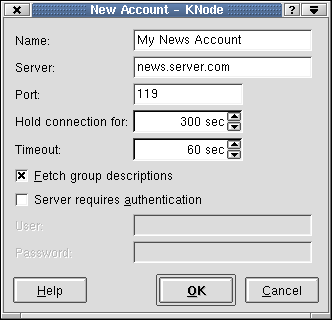
The dialog New Account
The field Name can be filled out as you like. The text you enter will later be visible in the folder view. You can e.g. enter the name of your Internet Provider. For our example we enter the name My News Account.
The next field is labelled Server. Unlike the field Name, it is not unimportant what you enter here. The name of the news server is fixed and should be made public by your Internet Provider. If you do not know the name of the news server, you should get it now. Without this information you can not read any news.
For our example configuration we enter the name news.server.de. You will of course enter the real name of your news server.
 | If you deploy KNode with a local news server, enter the name localhost here! |
Port, the next field, has already a default value. The Port designates, roughly speaking, a data channel, on which the server listens, whether someone wants to retrieve news. It defaults to the value 119, which is applicable in most cases. Therefore we do not change this default.
The time value you enter here is effective if you have established a connection to the news server and if, for whatever reason, no data is received from or transmitted to the news server. After the specified time has expired, KNode automatically disconnects. This, among other things, relieves the server of unneccessay connections which reduce its availibilty for other subscribers. It also makes sure that an automatically established Internet connection is not held unnecessarily although no data is being sent or received.
 | This settings mainly makes sense if one receives and reads news online. For local news servers it is of almost no importance. If this waiting time is set too low, there can be waiting periods if you read a longer article and do not do "anything" for some time. KNode has cancelled the connection to the server by then after the period has expired and has to reestablish it. If this waiting time is set too high, you perhaps waste online time when doing nothing. |
If KNode connects to the news server, it waits no longer for an answer of the news server than the time that is set here. If this period is exceeded, you will get a corresponding error message, because the server does not respond and KNode cancels the connection attempt.
 | Depending on the quality of your Internet account and the news server's current load. there can be waiting periods, so that KNode cancels the connection. If this happens frequently, you should set this setting to a higher value. |
If this setting is selected, KNode additionally requests the available group descriptions. They will be displayed in the dialog Subscribe to Newsgroups.
 | There is not a group description for every group, so there is no error if no group description is shown when subscribing to a group later on. |
The option Server requires authentication needs only to be selected if your news server requires a user name and a password when retrieving articles. If this is the case, you will find out from your Internet provider or the server's maintainer.
 | If you do not know exactly if this setting is necessary, forget about selecting it. If you encounter an error later on, you still can select it then. Otherwise select this option and enter your user name under User and the associated password under Password. |
By now you have completed the setup of your news account. Via the button Subscribe you can perhaps directly get to the dialog for subscribing to news groups. But we still have more to do and ignore it for now. There are several ways that lead to the goal.
You confirm and save your settings by clicking on the button OK. As soon as you have done that, the account will appear in the list by the name that you have entered in Name before. And if you have a close look, you will see that the account is also appearing in the folder view.
In the chapter Managing multiple news accounts you will learn how to work with multiple news accounts. But first, we will stay with this one. In most cases, one account is sufficient.
 | Please note that some Internet providers only allow retrieving news if you are logged on via this provider. |
We will now move on to configuring the e-mail account. In order to do that, click on the entry E-Mail in the tree view on the left.
After selecting Mail in the tree view, the following Dialog Box appears on the right.

Dialog Box for setting up the mail-account
You will notice this Dialog Box to be very simmilar to the news account settings Dialog Box. But why do we need an e-mail account in a newsreader?
Sometimes you need to anwser to the author of an article directly, without posting to the newsgroup. For example, when you want to make a very personal comment or want to correct an error. Sometimes a dialog is more appropriate than a public remark.
Thats why KNode provides the posssibility to reply by e-mail. If you want to use this feature, you must tell KNode how to send e-mails. You just need to insert the mailserver. When you have already configured an e-mail account, i.e with KMail, you can reuse the settings used there.
The name of your mailserver is not arbitrary. Your ISP, should provide you the informations, which mailserver to use. All you have to do here is to enter the mailserver in the Server field.
In our example we enter mail.server.de
 | You can send your mail by a local mailserver. When you use a local mailserver, use localhost in the Server field. |
Again, the Port field has a default value. In this case it Port 25. You should not need to change this, despite your ISP has a very exotic configuration nad tells you to do so. We do not change this for the example.
This value is important, after you established a connection with your mailserver. If there is no data transfer, KNode cancels the connection to your mailserver after this amount of time.
When KNode tries to connect to the mailserver, it waits this long for a reply by the the server. Is this time execceded, you get a error message.
 | Depending on the quality of your connnection and the actual load of your mailserver, you can get long reply times. If KNode cancels the connection due to this, you should increase the timeout. |
 | Some ISP only allow you to send e-mail over their mailserver after you checked your mailbox on new mails. This reduces spamming. For same reasons, some ISP only allow you to send mail by their mailservers, when you are onine with this ISP. |
In the next step we look at the general settings for reading news.
Now click on Read news and then on the subentry General. The picture shows the dialog and the preferences you can configure there.
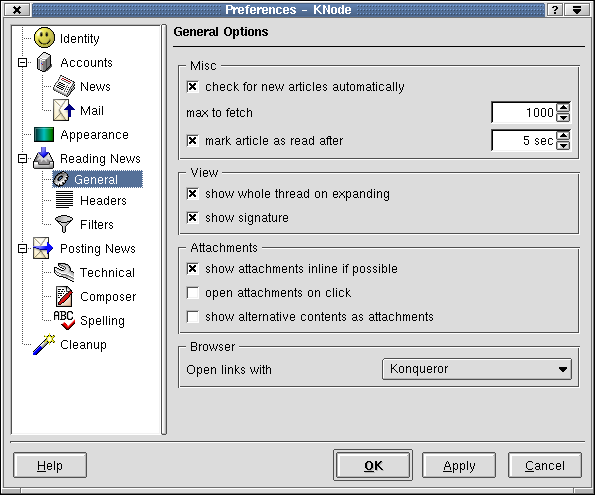
The dialog General Preferences
You don't need to change most of these settings, but we will discuss them step by step to give you an overview over the possibilities of KNode.
If this box is checked, KNode tries to request new articles from the server when selecting a newsgroup. These settings especially make sense when you use KNode together with a local news server. Downloading the messages obviously only works when the server is reachable. For a server which is only reachable via an Internet connection, this setting rarely makes sense and should stay deactivated.
If your system isn't set up to establish an Internet connection if neccessary, you will get an error message each time you select a newsgroup.
If you want to keep control over when a connection to the server is established, the menu option Group Get new articles is appropriate.
This sets the restriction of the articles, which are requested from the server while downloading. The value configured here is for each Newsgroup seperately. Set this for instance to 300, so that only the 300 newest articles of the newsgroup are requested. Other articles are discarded!
 | Please notice: For newsgroups with relatively high traffic you might lose articles if this value is too low. This especially occurs when you've just subscribed to a newsgroup or download articles only occasionally and the traffic for this reason rises above the value specified here. |
Articles you have opened in the article window are marked as read after the number of seconds specified here. If you set this value relatively high, you avoid that an articles you just glanced at is directly marked as read. On the other hand it can be annoying for relatively short articles for which you need less time to read than specified. If you browse in this case too fast through the articles they stay, although you've read them already, unread. Therefore, you should adjust this value to your personal preferences.
This setting lets discussion be displayed completely (over multiple answer levels, that is). If this setting isn't checked, only the immediate answers to the current article are displayed.
If this setting is activated, the signature of the sender is displayed in the article window, if it isn't, the signature is surpressed.
 | Please notice that KNode can display the signature correctly only if it can be seperated correctly from the article content in the current article. There are newsreaders which do this seperation incorrectly. Two "-" with a following " " (space) are correct. |
 | Many participants in the newsgroups give hints on their homepage or intentionally erroneous specified E-Mail adresses in the header in the signature. If you disable displaying the signature, you might loose those information. On the other hand you might save yourself from reading stupid texts. |
If this setting is marked, KNode tries to display the contents of possible attachment directly in the window when opening an article. For instance, a picture would be displayed directly below the article text.
Additionally, you have the possibility to save the attachment or open it with the application you have associated with the MIME type of the attachment by using the context menu.
If this box is checked, attachments are opened with an external program with is configured for the MIME type. If there is no such association, a dialog for saving a file is opened and you can save the attachment in a separate file.
Articles which are sent as Multipart MIME contain the text of the message in multiple formats, for example as raw text and HTML. The newsreader decides which part of the article is displayed. This setting makes it possible that the other formats can be opened as if they were attachments with a mouse click.
If this setting is disable, alternative contents are not displayed.
Here you can select which browser is used for displaying links you clicked on in a message. Currently, you can either select the Netscape Navigator or the default, Konqueror. The selected browser has to be installed, of course.
In this dialog, you can set how the single header lines are displayed in the article window.
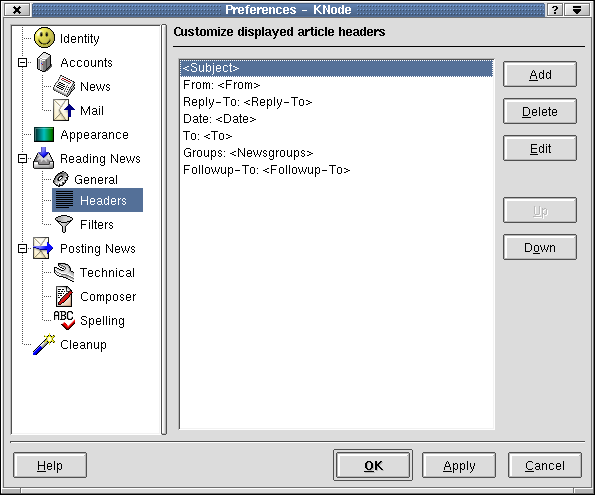
The dialog "Customize displayed article headers"
This list shows all the header lines which are intended for display in the article window. The identifier at the left will be displayed, the name in < > stand for the name of the according header line how it is transmitted in the Usenet, i.e. for From the name From
Via Edit you can influence the shown identifier as well as the attributes of the shown identifier and the text. To make things clearer, we'll now simply select the entry Sender in the list and open the dialog for editing the header display by clicking on Edit.
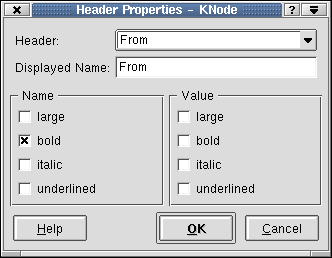
The dialog Header Properties
The selection box Header line shows the entry From. That is the name of the header line for the sender, as it's actually present in the article and evaluated by the newsreader. If you drop down the selection box, KNode shows a range of other identifiers, which stand all for a certain header line in the article. For now, we'll leave the identifier From configured. We'll work with this list later, when we add a header line to the display.
This field holds the name, which is later shown in the article window as a replacement for the actual identifier of the header line. For the header line From, it's the sender. If you leave this field blank, only the content of the header line appears in the article window. This is for example the default setting for the header line Subject. We won't change anything here either.
Here you can influence the attributes of the shown name with the checkboxes. In our case, the attribute Bold is selected for the name Sender, i.e. the text will be shown in bold letters in the article window. Of course, you can combine different attributes, for example Bold and Underlined.
The information given for Name is true for these checkboxes as well, but these attributes are associated to the content of the shown header line, in course case to the actual sender. You can later see the effects of these settings in the displayed articles. For example, select here the entry Italic, and the sender, i.e. "John Doe <johndoe@doubleguns.com>" appears in a italic font.
To explain the possibilities of this dialog to you, we're going to add a new header line to the display.
Example 4-1. Show the newsreader used for a post in the article window
This pictures shows the dialog with the header line X-Newsreader.
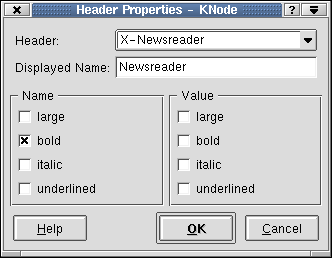
The dialog Header Display
It would be nice if one could see which newsreader another subscriber uses in the article window. Well, that's pretty easy because there's actually a (optional) header line which contains that information.
Drop down the selection field Header line and select the entry X-Newsreader from the list.
In the field Shown name, enter Newsreader.
Now you can select any attribute for the display of the field and it's content. Next, acknowledge your input with the OK. The new header line appers now in the list and will later be shown in the article window.
Use the up and Down buttons to arrange the order of the headers in the article window.
 | The statement that the new header line will be shown in the article window is actually pretty optimistic, because the entry X-Newsreader isn't required for Usenet artciles. Therefore, not all articles will contain that header line. If the line doesn't exist, the according entry simply won't be shown. |
With the dialog Appearance you are given the ability to set the colors, the character code and the font size of the texts in the article window. The picture shows the dialog.
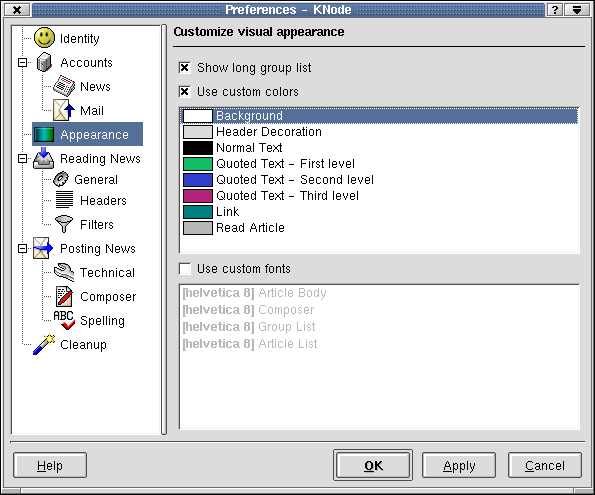
Setting up the dialog Appearance
If this setting is activated, KNode enlarges the folder view over the whole heigth of the main window. That way, the width of the article window is restricted to the area below the article view.
If this setting is deactivated, the article window can use the whole width of the main window.
If you select this option, you can adjust the color settings of KNode in the list field below. To change a color setting, do a double click with the left mouse button on the list entry to open the KDE color-selection dialog.
The color selection can only be configured after the checkbox has been checked - otherwise, a double click on the list entries won't do anything.
 | If the setting Use custom colors is selected, KNode won't use colors which have been changed later globally for KDE but will only use the colors defined here instead. |
If you select this setting, you can adjust the fonts which KNode uses for the display in the list field below. To choose a font, do a double click with the left mouse button on the list entry to open the KDE font-selection dialog.
The font can only be configured after the checkbox has been checked - otherwise, a double click on the list entries won't do anything.
 | If the setting Use userdefined fonts is selected, KNode won't use later changes to the global font settings for KDE but will use the fonts defined here instead. |
This screenshot shows the filter settings.
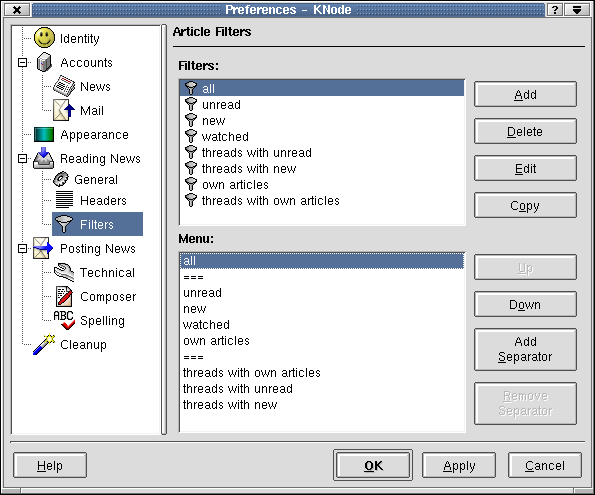
The filter settings
This dialog shows two lists. The upper list, labeled Filters, shows all defined filters. When you use KNode for the first time, you only see the predefined filters.
With the buttons Add, Delete, Edit and Copy you can add new filters or delete filters no longer needed. We skip this feature for now, because it is not essential for the setup of KNode
More detailed informations about filters you can find in Definig and using filters
The lower list, labeled Menu, shows the appereance of the menu View->Filter, which you can reach over the menu bar. The order of the filters in the this menu can be configured in this list.
The button Up shifts the selected article one position up. Try it, select the second filter and press Up. This entry goes up on position.
The button Down does the opposite action. Select the article, you just shifted one up, and press Down until it reaches its old position.
With the two buttons Add Separator and Remove Separator you can group the filters optical. The separators are shown as "====" in the list. In the Menu they show up as some more appealing horizontal lines. Try to add a separator. Then you select the seperator and remove it by pressing Remove seperator wider.
Any changes you make here, you can see in View->Filter after closing this dialog.
When you post articles with KNode the settings in the following Dialog Box is used.
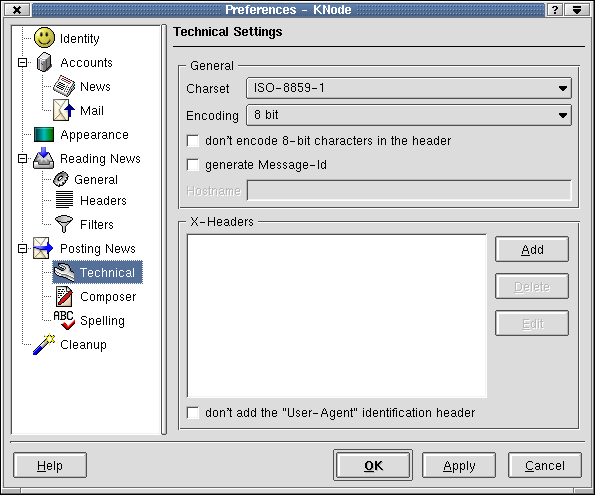
The Dialog Box Technical Settings
 | When you choose the wrong settings here, your articles can be unreadable or not sendable at all. So please be careful with these settings. |
Here you can choose the charset used for encoding your articles. Normally this is iso 8859-1 in Western Europe and english speaking countries, but your charset may differ. The default is the charset used in your global KDE settings, so you should not have to change this.
When you want to post articles in newsgroups with other charsets (i.e. eastern-european or asian) you can set the needed charset here.
Here you set the encoding of the characters for the message transfer. You can choose between 7-bit, 8-bit and quoted-printable.
When you choose 7-bit encoding, special characters are not correctly send. 7-bit is kind of restricted to the us-ascii charset.
When you choose 8-bit encoding, most special characters are transfered.
When you choose quoted-printable, 8-bit charcters are send as encoded 7-bit charcaters.
This setting allows 8-bit characters in the header, if checked, i.e. in the subject. This is explicitly not allowed by the standard.
This setting is made for a special case, because in scandinavian newsgroups, standard encoded 8-bit characters in the headers are reasonably common.
 | You should normally never use this option, unless you know for certain this is normal in the newsgroup you are posting to. |
When this is active, KNode generates its own Message-IDs for all articles you post.
 | The Message-ID must be unique worldwide! There will be collisions between messages with the same Message-ID, otherwise. The newsserver will reject the second article, because it thinks, this article was already recieved. A Message-ID consists of a valid FQDN (Full Qualified Domain Name). This means it looks similary to an e-mail adress with a indentification befor the @ and the domain. The identification is generated by KNode automatically, but you must provide a valid domain name in Hostname When you do not have your own domain, you should not activate this option. Let the newsserver generate a Message-ID for you. Example 4-2. Message-ID An example for a valid domain would be: kde.org. A Message-ID gernerated with this domain will look like: 934lek9934@kde.org An uniqe identification is only guarenteed, when you have your own domain. Even when you do not use KNode for generating your Message-IDs there may be collisions, when you are using a local newsserver. For example leafnode generates a Message-ID which it derives from the local hostname. |
Here you enter the Hostname of your computer. This is used to generate the Message-ID. When you do not have your own domain, you should not activate this option. Let the newsserver generate a Message-ID for you. Using the example above this would be: kde.org
Here you can enter X-Headers, wich are not provided by KNode For example: X-No-Archive: yes. This should prevent your articles to be archived by i.e. dejanews.
X-Headers are experimental headers, wich are not included in the standard for Internet-Messages. They are, for example, used for extended information transfer. To prevent collisions with later standard headers, they have a "X-" prefix.
When this option is checked, KNode does not include the according line in the Header before posting.
This header is used for identification of the newsreader the article was written in. Besides statistical reasons, this allows to identify non-standard newsreaders. You should not activate this option, KNode has no need to hide.
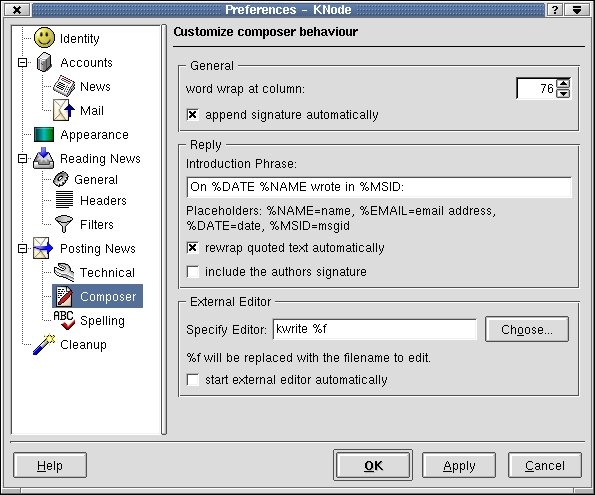
The Composer settings Dialog Box
Here you can set the value at which KNode wraps the line.
 | It is recomended to use no more than 76 characters. Even when you are able to diable more. Many Usenet users will use a text-based newsreader which can not display more than 80 characters. It is difficult to read your articles in such a newsreader, if you increase this value. This reduces the probatility of your articles to be read at all. |
When you write a new article, or a folloeup, your signature is appended automatically, if you have configured one in Settings->Preferences+Identity.
When you write a followup, KNode inserts an introdutionary phrase befor the quoted orginal Text. You can put an aribrary text here. You can use variables, which KNode extracts from the original article, i.e. the name of the author or the date the article was written.
The following variable are available:
The name of the original author.
The date the original article was written.
The original authors e-mail adress.
The Message-ID of the original article.
 | Keep this short, because this introdutionary line appears in every followup. A too long introducionary line can be as repelling as a too long signature. |
Example 4-3. An example
On %DATE %NAME wrote in %MSID
Let us assume the original article was written by Konqui on Saturday the 17th of June at 17:42:32 - 0500. The article has the Message-ID <8igdg5.3vvijgt.3@lizard.physos.com>. KNode will then insert the following introductionary line.
On Sat, 17 Jun 2000 17:42:32 +0200 Konqui wrote in <8igdg5.3vvijgt.3@lizard.physos.com>:
When this is checked, the quoted text is wraped at the correct border value. So, every new line is in the correct quoting level.
When this is activated, not only the text of the original message, but also the signature of the author is quoted in a reply.
 | Quoting a signature is unnecessary and is often considered impolite. |
You can define an external editor here, wich is opened by selecting Edit->Start external editor in the Composer window.
When start external editor auotmatically is checked, the external editor is opened directly.
 | Notice the %f behind the name of the editor. This is a variable for the filename of the article you want to edit. Do not delete this. You will get an error message when opening the external editor. |
 | When you have problems with starting your external Editor, the reason may be the editor starting in "the background". This is called forking. KNode only notices the process started, is finished and thinks you have quit the editor. The editor gvim is an example for this. You can disable the forking of gvim by the commandline switch -f. It is recommended to refer to the documentation of the used editor for this. When you want to use gvim in Specify Editor use the following input: gvim -f %f |
The dialog below, shows the settings for the article cleanup. These settings are used to keep the amount of articles on your local harddisk in a reasonable value. KNode administrates the articles in memory, so there can be some decrease in speed, if you have to many articles lying around. Most of the time it makes no sense to keep articles for a very long time. Services like Dejanews and Altavista make archiving needless.
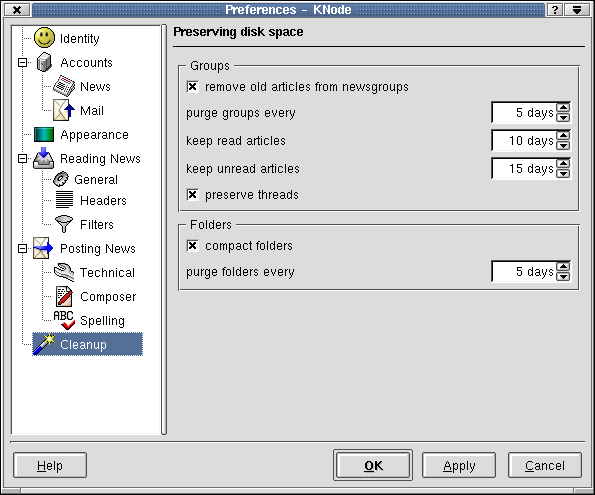
The cleanup settings
When this option is active, all subcribed groups are checked for old articles in the time intervall set here. The old articles are deleted, then.
 | You can force this check by selecting Group->Expire now |
Read articles are deleted by the next cleanup, if they are older than this value. KNode uses the make date for this.
Unread articles are deleted by the next cleanup, if they are older than this value. KNode uses the make date for this.
This selection forces a thread, only to be deleted, if all articles contained, fulfill the delete conditions.
This prevents old articles in a long thread to vanish, before the dicussion is ended.
 | KNode can not predict, if there is a reply, after the set conditions are fulfilled. You have to find your own settings for this. Some newgroups have days between replys, others only hours. Use your own judgement. |
After the time, set here, KNode removes all deleted or moved articles finally from the folders.